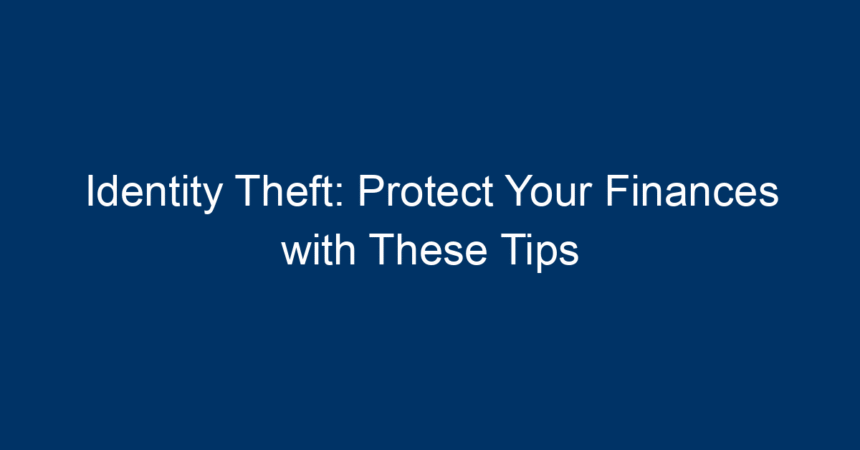In today’s digital age, identity theft has become a pressing concern for millions of individuals across the globe. From hackers and cybercriminals gaining access to your personal information to the misuse of stolen data for financial gain, the impact of identity theft can be devastating. Imagine waking up one day to find that your credit card information has been compromised, or worse, that someone has applied for a loan in your name. The financial and emotional fallout can be overwhelming. Fortunately, there are measures you can take to safeguard your financial identity. In this comprehensive guide, we’ll explore effective strategies to protect against identity theft and ensure your finances remain secure.
Understanding Identity Theft
Identity theft happens when someone unlawfully acquires and uses your personal information—such as your name, Social Security number, or bank details—without your consent. You might be surprised to learn that identity theft isn’t always perpetrated by strangers; in many cases, it’s someone you know. This breach of trust can lead to significant financial loss, damaged credit ratings, and a long, arduous process to restore your good name.
Types of Identity Theft
-
Financial Identity Theft: This occurs when someone uses your personal information to access your financial accounts or open new accounts in your name.
-
Medical Identity Theft: In this scenario, thieves use your identity to obtain medical services or medications, leaving you with the bills and potential health complications.
-
Criminal Identity Theft: Criminal identity theft happens when someone uses your identity during unlawful activities, often leading to fines, criminal records, or other legal troubles for you.
-
Child Identity Theft: Unfortunately, children are often targets for identity theft because their personal information is less likely to be monitored.
- Synthetic Identity Theft: This involves the creation of a new identity using a combination of real data (like your Social Security number) and fictitious information.
Understanding the types of identity theft can help you recognize potential threats and act swiftly.
The Financial Impact of Identity Theft
The repercussions of identity theft can be far-reaching. Victims often face:
-
Credit Issues: The misuse of your credit can negatively affect your credit score, making it difficult to borrow money or secure loans in the future.
-
Financial Loss: Whether it’s money stolen from your accounts or high-interest debt accrued in your name, the financial burdens can be insurmountable.
- Emotional Distress: The psychological impact of having your identity stolen should not be underestimated. Many victims of identity theft experience feelings of anxiety, confusion, and helplessness.
Proactive Steps to Protect Your Identity
Taking proactive measures is essential for safeguarding your finances. Here are some practical tips to help you do just that.
1. Strengthen Your Passwords
One of the simplest yet most effective measures to prevent identity theft is using strong, unique passwords for all your online accounts.
-
Use a Mix of Characters: Include uppercase and lowercase letters, numbers, and special symbols.
-
Avoid Common Phrases: Don’t use easily guessable information, such as your birthday or pet’s name.
- Employ a Password Manager: This tool can help you create and store complex passwords securely.
2. Enable Two-Factor Authentication (2FA)
Wherever possible, enable two-factor authentication on your accounts. This adds an extra layer of security by requiring not just your password but also a second form of verification, such as a text message code or email link.
3. Regularly Monitor Financial Statements
Keep a close eye on your bank and credit card statements. Look for any unauthorized transactions, no matter how small, as they can be the first signs of identity theft.
-
Set Up Alerts: Many banks offer transaction alerts via text or email to notify you of any account activity.
- Check Your Credit Report: Request a free credit report at least once a year. Look for unfamiliar accounts or inquiries that you did not initiate.
4. Secure Your Personal Information
Be mindful of how and where you share your personal information. Here are some steps to consider:
-
Shred Documents: Shred bank statements, credit card offers, and personal documents before discarding them.
-
Limit Public Information: Be cautious about sharing personal details on social media, as this can provide thieves with valuable data.
- Avoid Unsecure Wi-Fi: Public Wi-Fi networks are often not secure, making them a prime target for identity thieves. Use a virtual private network (VPN) if you need to access sensitive information on public Wi-Fi.
5. Use Security Software
Invest in reputable security software for your devices. This software can help safeguard against viruses, malware, and phishing attacks designed to steal your personal data.
6. Document Your Personal Information
Keep a record of important personal information (e.g., Social Security number, bank account numbers) in a secure location, like a safe. This will make it easier to respond and take action should your accounts become compromised.
7. Consider Identity Theft Protection Services
For an added layer of security, consider subscribing to an identity theft protection service. These services monitor your personal information on the dark web and alert you of any suspicious activity.
What to Do if You Become a Victim of Identity Theft
Taking swift action if you discover that you’ve become a victim of identity theft is crucial.
1. Notify Your Financial Institutions
Contact your bank, credit card companies, and any other financial institutions involved. Report any unauthorized transactions and place fraud alerts on your accounts.
2. File a Report
File a report with the Federal Trade Commission (FTC) at IdentityTheft.gov. This is crucial for documenting your case and providing guidance on the next steps.
3. Contact Credit Bureaus
Reach out to the three major credit bureaus—Equifax, Experian, and TransUnion—to place a fraud alert on your credit reports. Consider placing a credit freeze to prevent new accounts from being opened in your name.
4. Document Everything
Keep detailed records of communications, reports filed, and any steps you take to resolve the issue. This documentation will be invaluable should any disputes arise.
Conclusion: Staying One Step Ahead
Identity theft may seem daunting, but taking proactive measures can significantly mitigate the risks associated with it. By strengthening your password practices, monitoring your financial statements, and securing your personal information, you can protect your finances from potential threats. Remember, staying informed and vigilant is your best defense against identity theft.
Whether you’re a college student, a working professional, or retired, everyone can be a target. Equip yourself with the knowledge and tools to safeguard your identity today. If you have additional tips or experiences regarding identity theft, feel free to share them in the comments section. Together, we can foster a community that prioritizes financial security and protects against identity theft.
By implementing these actionable insights, you’ll be better prepared to guard your financial identity and enjoy peace of mind in a digital world fraught with risks. Stay safe out there!




